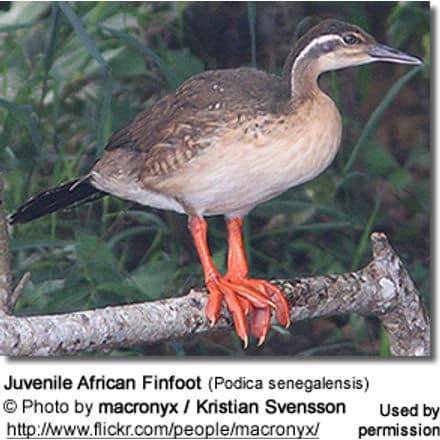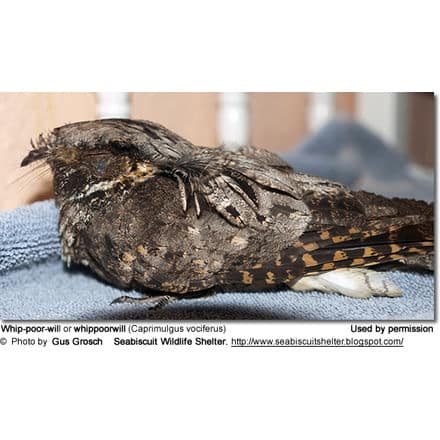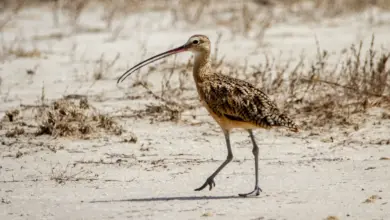African Finfoots
The African Finfoots (Podica senegalensis) are aquatic birds found in tropical Africa by streams in woodland areas.
Subspecies and Ranges
- Podica senegalensis senegalensis (Vieillot, 1817) – Nominate Form
- Range: Occurs in Senegal east mostly through a forested belt of western Africa to eastern parts of the Democratic Republic of the Congo, Uganda, northwestern Tanzania and Ethiopia.
- Range: Occurs in Kenya and northwestern Tanzania.
- Range: Found in Cameroon, Gabon, Congo, and northern parts of the Democratic Republic of the Congo
- Range: Angola east to southeastern areas of the Democratic Republic of the Congo, Zambia, and Mozambique, and south to eastern South Africa.

Alternate (Global) Names
Afrikaans: Watertrapper … Chinese: ????? … Czech: Chrástalec africký, ch?ástalec africký … Danish: Afrikansk Svømmerikse … Dutch: Afrikaanse Fuutkoet, Watertrapper … Estonian: aafrika redulind … Finnish: Afrikanuikkukana … French: Grébifoulque d’Afrique, Grébifoulque du Sénégal … German: Afrikanische Binsenralle, Binsenralle … Italian: Rallo tuffatore africano, Svasso folaga africano … Japanese: afurikahireashi … Norwegian: Flekksvømmerikse … Polish: perkolyska afrykanska, perko?yska afryka?ska … Portuguese: Pes-de-barbatana, Pés-de-barbatanas … Russian: ??????????? ?????????? … Slovak: chriaštelovec pásavý , Chriaštel’ovec pásavý, Chriaštel’ovec trst’ový … Spanish: Ave de Sol Africana, Ave del sol africana, Avesol Africano … Swedish: Afrikansk simrall … Swahili: Kiguudau
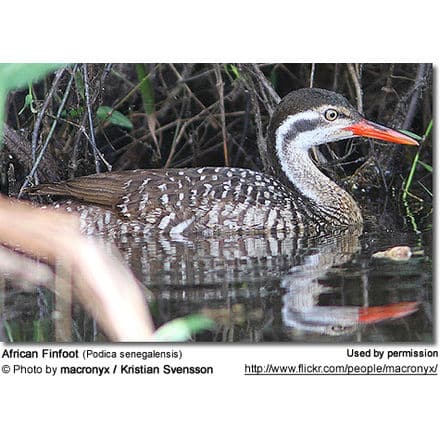
Distribution / Range
The African Finfoots inhabit large expanses of land and water in western, central, and southern Africa. They inhabit much of sub-Saharan Africa, from Senegal to Western Ethiopia and south through D.R. Congo, Angola, Zimbabwe, Central Mozambique, and Northeastern and Southern South Africa.
They are found in areas that contain rivers, fast-moving streams/rivers, coastal creeks, lakes, and large, moving bodies of water.
They require large bodies of water containing vegetation; these provide protective covering on their banks. Their range includes forest, wooded savannah, flooded forest, reed beds, and mangrove swamps.
Finfoots are highly secretive, and thus much of their biological data has not been discovered by ornithologists. Because they are so reserved, Finfoots often go unseen. They are territorial most of the time and definitely during breeding season. Although they do not migrate, they do disperse in order to form new colonies in preferred habitats.
They are usually seen singly or in pairs. Since they do not fly well, they stay near shady, calm waterways.
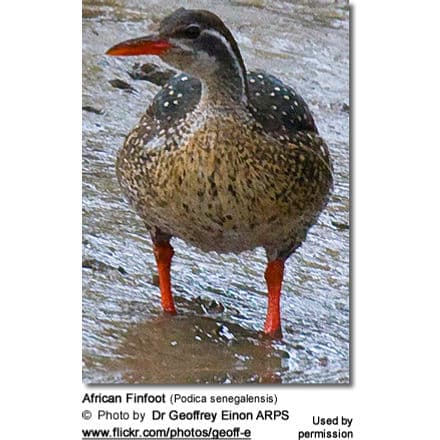
Description
The African Finfoots (Podica senegalensis) is the largest of all finfoot species, measuring 46–53 cm (18–21 inches) long. The Sungrebe (or American Finfoot) is only half the size of the African Finfoot.
This cormorant-shaped bird’s back is dark brown and spotted white. It has a grey head with a white stripe running from behind the eyes down the side of the neck.
The African Finfoots is an underwater specialist with a long neck, a striking red sharp beak, and bright red, lobed feet, as is typical of the Finfoot family and from which its common name has been derived. Their webbed, lobed feet allow them to be agile and graceful underwater.
The plumage varies by race, generally pale underneath and darker on top. The males are usually darker than the females, the male’s chin is black and the female’s chin is white.
Similar Species:
The African Finfoot superficially resembles South America’s Torrent Duck.
Finfoots are similar to Rails, with long necks, small heads, slender bodies, broad tails, and long, tapered, sharp, pointed bills.
Diet / Feeding
The African Finfoot mostly feeds on underwater invertebrates, including both adult and larval mayflies, dragonflies, crustaceans, grasshoppers, crabs, frogs, snails, spiders, shrimps, millipedes, beetles, mollusks, fish, amphibians, and some leaves and seeds.
Finfoots are thought to be highly opportunistic; rather than diving for their food, they will forage on the water’s surface near the shore for their prey. Unlike the Grebes, they do very well on land, feeding from overhanging vegetation.
Breeding / Nesting
Most breeding activities occur from August to April, after the rainy season ends. During the breeding season, the Male African Finfoot’s plumage changes (breeding plumage).The Finfoots are monogamous.
The untidy bowl shaped nest is constructed with twigs, stalks, reeds, course grass and leaves and usually placed on a sloping branch or fallen tree suspended above the water, often in driftwood that got caught in the branches.
The average clutch consists of 1 – 2 pale buffy green eggs with brown and purple streaks, which are incubated by the female alone for about three weeks.
The precocial African Finfoot chicks leave the nest a few days after hatching.

